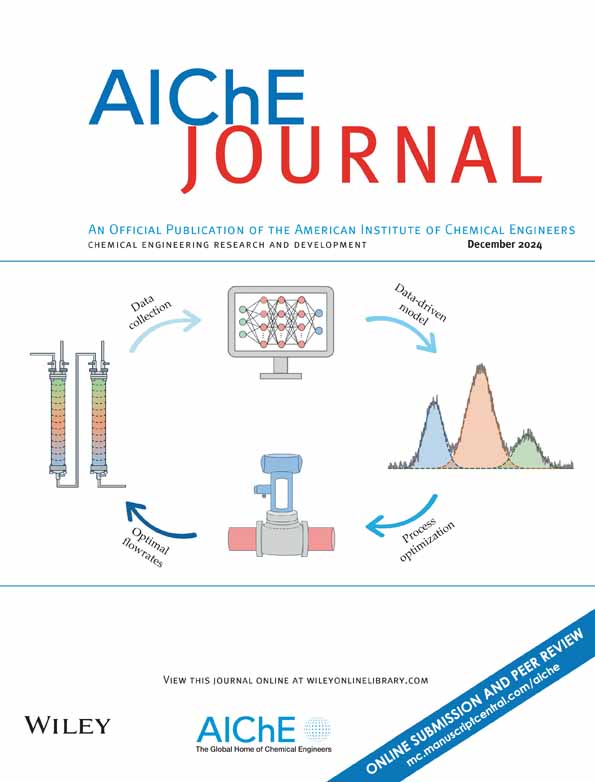Construction of dual cofactor-driven biocatalytic system for effective production of chiral amino acids
IF 3.5
3区 工程技术
Q2 ENGINEERING, CHEMICAL
引用次数: 0
Abstract
Asymmetric reductive amination is essential for producing chiral amino acids, yet optimizing intracellular cofactor utilization for this process remains challenging. Herein, we developed a dual cofactor-driven biocatalytic system (DuCoCat) that utilizes both intracellular NAD(H) and NADP(H). Initially, the cofactor dependence of a glutamate dehydrogenase (GluDH) was engineered to exhibit dual cofactor preference, achieving a 163.3-fold increase in cofactor-preference factor. This engineered GluDH was coupled with a dual cofactor-dependent glucose dehydrogenase to form a DuCoCat system. To improve the efficiency of the DuCoCat system, we developed a kinetic model for the DuCoCat system and applied metabolic engineering to enhance intracellular cofactor concentrations, thereby optimizing the DuCoCat-driven biocatalytic process. This approach led to efficient and cost-effective amino acid synthesis with high space–time yield. Scale-up experiments were conducted for the synthesis of L-phosphinothricin, and an economic analysis based on optimized scale-up data demonstrated the process's commercial viability.双辅因子驱动手性氨基酸生物催化体系的构建
不对称还原性胺化是产生手性氨基酸的必要条件,但优化细胞内辅助因子利用这一过程仍然具有挑战性。在此,我们开发了一种双辅因子驱动的生物催化系统(DuCoCat),它利用细胞内NAD(H)和NADP(H)。最初,谷氨酸脱氢酶(GluDH)的辅助因子依赖性被设计为双辅助因子偏好,使辅助因子偏好因子增加163.3倍。该工程GluDH与双辅因子依赖性葡萄糖脱氢酶偶联形成DuCoCat系统。为了提高DuCoCat系统的效率,我们建立了DuCoCat系统的动力学模型,并应用代谢工程技术来提高细胞内辅因子的浓度,从而优化DuCoCat驱动的生物催化过程。该方法实现了高效、低成本、高时空产率的氨基酸合成。对l -膦丙酸进行了放大实验,并根据优化的放大数据进行了经济分析,证明了该工艺的商业可行性。
本文章由计算机程序翻译,如有差异,请以英文原文为准。
求助全文
约1分钟内获得全文
求助全文
来源期刊

AIChE Journal
工程技术-工程:化工
CiteScore
7.10
自引率
10.80%
发文量
411
审稿时长
3.6 months
期刊介绍:
The AIChE Journal is the premier research monthly in chemical engineering and related fields. This peer-reviewed and broad-based journal reports on the most important and latest technological advances in core areas of chemical engineering as well as in other relevant engineering disciplines. To keep abreast with the progressive outlook of the profession, the Journal has been expanding the scope of its editorial contents to include such fast developing areas as biotechnology, electrochemical engineering, and environmental engineering.
The AIChE Journal is indeed the global communications vehicle for the world-renowned researchers to exchange top-notch research findings with one another. Subscribing to the AIChE Journal is like having immediate access to nine topical journals in the field.
Articles are categorized according to the following topical areas:
Biomolecular Engineering, Bioengineering, Biochemicals, Biofuels, and Food
Inorganic Materials: Synthesis and Processing
Particle Technology and Fluidization
Process Systems Engineering
Reaction Engineering, Kinetics and Catalysis
Separations: Materials, Devices and Processes
Soft Materials: Synthesis, Processing and Products
Thermodynamics and Molecular-Scale Phenomena
Transport Phenomena and Fluid Mechanics.
 求助内容:
求助内容: 应助结果提醒方式:
应助结果提醒方式:


